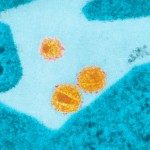Link to Pubmed [PMID] – 15166245
J. Biol. Chem. 2004 Jul;279(31):32035-45
The molecular mechanisms involved in the hepatic tropism of hepatitis C virus (HCV) have not been identified. We have shown previously that liver-expressed C-type lectins L-SIGN and DC-SIGN bind the HCV E2 glycoprotein with high affinity (Lozach, P. Y., Lortat-Jacob, H., de Lacroix de Lavalette, A., Staropoli, I., Foung, S., Amara, A., Houles, C., Fieschi, F., Schwartz, O., Virelizier, J. L., Arenzana-Seisdedos, F., and Altmeyer, R. (2003) J. Biol. Chem. 278, 20358-20366). To analyze the functional relevance of this interaction, we generated pseudotyped lentivirus particles presenting HCV glycoproteins E1 and E2 at the virion surface (HCV-pp). High mannose N-glycans are present on E1 and, to a lesser extent, on E2 proteins of mature infectious HCV-pp. Such particles bind to both L-SIGN and DC-SIGN, but they cannot use these receptors for entry into cells. However, infectious virus is transmitted efficiently when permissive Huh-7 cells are cocultured with HCV-pp bound to L-SIGN or to DC-SIGN-positive cell lines. HCV-pp transmission via L-SIGN or DC-SIGN is inhibited by characteristic inhibitors such as the calcium chelator EGTA and monoclonal antibodies directed against lectin carbohydrate recognition domains of both lectins. In support of the biological relevance of this phenomenon, dendritic cells expressing endogenous DC-SIGN transmitted HCV-pp with high efficiency in a DC-SIGN-dependent manner. Our results support the hypothesis that C-type lectins such as the liver sinusoidal endothelial cell-expressed L-SIGN could act as a capture receptor for HCV in the liver and transmit infectious virions to neighboring hepatocytes.

